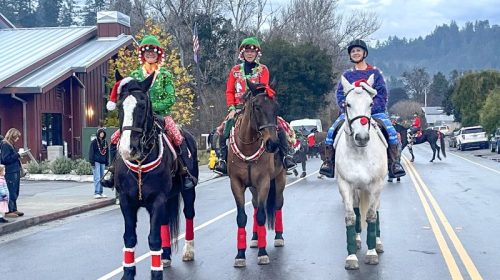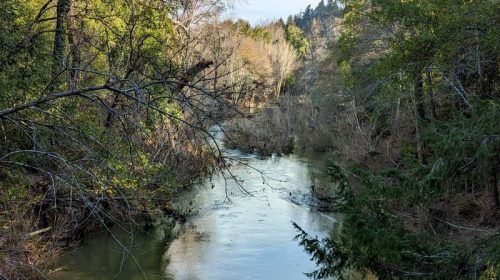A Primer on our Local Water System
By Mark Dolson
Many people these days feel frustrated and powerless in the face of the polarization and dysfunction in our national government. In contrast, local government provides an arena in which our voices can have a direct impact. But how well are you and I fulfilling our democratic responsibility to ensure that our input is well informed? The San Lorenzo Valley Water District (SLVWD) – a public resource directly controlled by the citizens of our valley – is a perfect place to put our principles to the test. Are we just casting occasional votes, or are we committed to developing a deeper understanding of the specific challenges SLVWD is grappling with?
Happily, SLVWD has an adequate supply of good-quality, local water to meet our needs for the foreseeable future. The District’s strategy is to rely principally on surface water (from creeks) and to supplement this, as needed, by pumping groundwater. To ensure that SLVWD manages these critical resources responsibly, it must comply with various state requirements, and it must also pay for and participate effectively in long-term regional water management initiatives (such as the Santa Margarita Groundwater Agency, which began meeting in 2017 in response to a new state law).
To reliably deliver water to its customers, SLVWD ultimately needs to balance its expenses with its income. The bulk of the District’s budget is devoted to everyday operating expenses (which are dominated by the costs associated with its 35 staff positions), but the District also needs to invest in its physical infrastructure such as storage tanks, pumps, treatment plants, and pipelines. Some of this investment is targeted at essential maintenance and upgrades (much of which has been repeatedly deferred due to insufficient funding), but another big chunk of recent infrastructure spending has been devoted to critical repairs in the wake of the CZU Fire and 2023 storm damage. One very expensive and challenging repair project (replacing the seven miles of raw water pipeline destroyed in the CZU Fire) is entering its third year of planning.
To pay for these expenditures, SLVWD has only two significant options. Most of the District’s income comes directly from charges to its roughly 8000 customers. Whenever possible, though, the District tries to supplement this revenue with state and federal grant funding. 90% of the “allowable” CZU repair costs are being covered by FEMA along with 75% of the “allowable” 2023 storm damage repair costs. (The District’s current five-year Special Assessment is intended to cover the remainder of the CZU repair costs, but as these kinds of costs continue to escalate, it is likely that the District will ultimately need significantly more.) In addition, the District has recently been awarded over $6 million in state grants for special projects such as the pending consolidation of the Bracken Brae and Forest Springs mutual water companies, replacement of outdated meters and tanks, fire hardening of infrastructure, and the state-mandated Fall Creek Fish Ladder.
Both SLVWD staff and the Board of Directors have been highly attentive in recent years to trying to increase revenue and decrease operating expenses. For example, the District hired a consultant in 2022 to assist with grant writing, and this investment has paid off many times over. The District has also pursued new avenues for collecting money it is owed for delinquent accounts. On the expense side of the ledger, the District has reduced front-office costs, partly via its promotion of automated billing. It has reduced construction spending by expanding its engineering department, enabling it to perform some work more cost-effectively in-house. District salaries have also decreased due to the (sometimes problematic) departure of senior personnel for more attractive opportunities elsewhere. (Ironically, the District is also arguably underspending on educating its customers about its ongoing activities and challenges – this can potentially backfire if an insufficiently informed public fails to appreciate the District’s recent progress.) Lastly, some of the District’s pending infrastructure improvements will eventually translate into savings (e.g., by reducing water loss due to leakage and enabling a shift to lower-cost time-of-use power rates).
Despite these efforts, the harsh reality is that the District’s operating expenses are relatively high and are continuing to climb even as its revenues remain flat or decline (due, in part, to decreased water consumption by conservation-conscious customers). Worse, the District should ideally be spending even more, as it now has a long history of deferring infrastructure improvements due to insufficient revenue. How can this be? The relatively high operating cost for SLVWD is closely tied to its widely distributed aging infrastructure, the steep, mountainous terrain, and, now, storm damage as well. Meanwhile, the escalating expenses are consistent with many other districts across the state.
Drilling down further: roughly 70% of the District’s operating expenses are devoted to salaries and benefits, and these have approximately doubled over the past ten years. This expansion is partially due to annual raises that are a standard part of maintaining a highly competent workforce in a competitive job market, and it is also partially due to increases in headcount necessitated by changing conditions such as the Lompico merger and escalating state demands. In the most recent round of labor negotiations, the District notably agreed to pay a one-time bonus of 7%, but it did this in recognition of the extraordinary staff effort and extensive overtime in the years following the CZU Fire. In parallel, the District committed to conducting a formal salary survey to definitively establish how staff salaries stack up against those in comparable districts.
In addition to this salary study, the District is conducting a formal rate study, its first since 2017. This study will perform a detailed examination both of the revenue the District requires to operate effectively and of ways of structuring rates to minimize the burden on those least capable of paying more. The findings will be presented to the public this fall, and there is certain to be some resulting sticker shock.
The challenge for our community in responding will be to engage with the reality described above: we can’t reasonably demand lower water rates unless we can clearly articulate a detailed strategy for meeting our needs with less, and nobody has yet been able to do this. Ultimately, the question we need to answer isn’t simply whether we would like our water rates to be lower (of course we would!), but whether SLVWD is operating as effectively as possible to deliver safe, reliable, and affordable water. This, in turn, requires that we understand what it takes for SLVWD to fulfill this mission.
Mark Dolson is a member of the local citizens’ group Friends of San Lorenzo Valley Water (FSLVW), but he is writing here as a private citizen. FSLVW articles, initiatives, and Board meeting summaries are available online at friendsofsanlorenzovalleywater.org.
Featured photo: Felton customers obtain their water entirely from surface sources such as Fall Creek, pictured here. In emergency situations, which we are currently in, the water is shared throughout the district. (Photo by Julie Horner)
The San Lorenzo Valley Post is your essential guide to life in the Santa Cruz Mountains. We're dedicated to delivering the latest news, events, and stories that matter to our community. From local government to schools, from environmental issues to the arts, we're committed to providing comprehensive and unbiased coverage. We believe in the power of community journalism and strive to be a platform for diverse voices.





